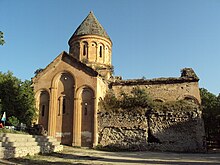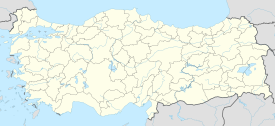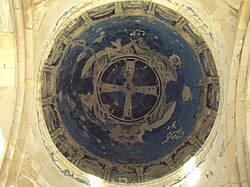Ishkhani
| Ishkhani | |
|---|---|
 Ishkhani monastery | |
| Location | |
| Location | İşhan, Yusufeli District, Artvin Province, |
| Geographic coordinates | 40°47′08″N 41°44′49″E / 40.78565°N 41.74698°E |
Ishkani or Ishkhan, (Armenian: Իշխան, prince, Georgian: იშხანი, Turkish: Işhan) is a ruined Christian monastery in the territory of Turkey in the village of İşhan, Artvin province. The name Ishkhani derives from the word “Իշխան” (Ishkhan) which means “prince” in the Armenian language. It was one of the important spiritual centers in the Middle Ages Tayk/Tao-Klarjeti. Only the magnificent church and the adjacent chapel have survived. The earliest mention of the monastery is found in The Life of Grigol Khandzteli, a Georgian manuscript dating from the year 951, which is now kept in Jerusalem.
In this manuscript it is stated that Saba, the nephew and follower of the priest Gregory of Khandzta,[1] founded a monastery on the site of an earlier church. The first church built by catholicos Nerses III (641-661), who was native from the village of Ishkhan, and is also known as Nerses III Ishkhanetsi,[2][3][4] had a tetraconch plan (a central dome with four apses radiating to the cardinal points) and was presumably damaged during the Arab invasions of the 7th century. Five Georgian inscriptions within the church and on the southern facade indicate different restoration periods, from 917 until 1032. From the 12th to the end of the 14th century, large vestibules were added to the south, west and north facades. The monastery used to be one of the five patriarchates of Tao-Klarjeti and its church functioned as a cathedral until the 17th century. It was used as the headquarters for the Ottoman officers during the Russo-Turkish War in the 19th century, while its west arm was converted into a mosque and remained so until 1983. In 1987, the Ministry of Culture and Tourism (Turkey) registered İshkhhan as a national cultural monument and the site is now protected. In 2013, the Monastery was being renovated.[5]
Architecture[edit]

The church (outer dimensions 35.00 x 20.70 meters) is a domed cruciform structure. The dome over the central square bay rests on four free-standing piers, each having a diameter of about two-meters. The eastern cross-arm is extended with an apse that has a unique arrangement. A horseshoe-shaped arcade whose arches rest on eight monolithic columns with decorated cubic capitals opens on to a rectangular ambulatory. The rooms flanking the apse have upper stories. There are two-story pastophoria which were used to store priestly vestments and altar furniture.
The elongated west cross-arm is about three times deeper than the south and north cross-arms. During the conversion of the church into a mosque, a wall was constructed between the west arm and the central bay, the south and west entrances were closed, a mihrab niche facing in the direction of Mecca was constructed within the closed southern entrance, and the northern annex was converted into a prayer hall.

In 966, the interior walls of the church were covered with frescoes. Only the paintings in the cupola and the drum have come down to us. In the cupola the “Ascension of the Cross” is depicted, where a jeweled cross is being carried by four flying angels. Below this scene, repeated four times at each axis, is a two-wheeled chariot, drawn by four winged horses and driven by a standing figure. Above each chariot there is a Georgian inscription mentioning the colors of the horses. This repetitive scene is generally accepted as depicting the “Vision of Zachariah” (6:1-6) from the Old Testament.
Within the blind arcade of the drum, eight standing figures alternate with eight windows. During the restoration work in 1032 the heads of these figures identified as prophets by some scholars, were replaced by round openings. Above each prophet, in a circular niche, an angel holding a scepter is depicted. On the arches of the windows there are the busts of other holy figures. The rest of the frescoes found on the north, south and west walls are severely damaged and are in need of restoration. However, a female figure dressed in blue, carrying a diadem and holding a church model in her hand can still be observed on the intrado of the northwestern window. This figure has been interpreted by scholars either as the Cappadocian Saint Nino, who converted the Georgians to Christianity, or the first Christian[6] queen of Georgia, or a symbol of the church itself.
The facades of the church constructed with well-cut, multi — coloured stones are enlivened by recessed blind arcades and deep triangular niches. The same arrangement is repeated on the dome of the drum where the blind arcades enclose rectangular and circular windows. The conícal roof of the dome is covered with alternating rows of dark red and grey coloured glazed tiles.
22 different geometric and floral motives are employed in the sculptural decoration of the church. The patterns of the capitals and bases of the columns, of the arches and window frames, of the drums and cornices do not follow a strict decorative program. The only figurative decoration, a combat between a lion and what may be a dragon or a snake, can be seen on the sill of a window on the southern façade of the west cross-arm.
According to the Georgian inscription placed on the entrance of the chapel, situated to the southwest of the cathedral, King Gurgen I (died 1008) dedicated the chapel to the Holy Mother of God. Constructed in 1006, the chapel (outer dimensions 10.30x5.70 meters) is a single-naved, vaulted structure with an apse and two windows, one to the east and the other to the west.
The arches of the entrance and windows are decorated with geometric, floral and figural motives. Animals and legendary creatures are depicted within the geometric patterns. It seems as if the interior walls of the chapel used to be covered with frescoes. However, only the figures in the apse, including a portrayal of the enthroned Christ can still be identified.
Fortress[edit]
Ruins of a mediaeval fortress of the same name were found on the rocky mountain to the northwest of the church.[7] The fortress was probably one of the most important fortifications in Tao-Klarjeti, and once served as refuge to then Prince Giorgi, the future George V of Georgia.[8] İbrahim Peçevi is reported to suggest that the fortress was probably demolished during an Ottoman campaign in 1549.
Gallery[edit]
-
Outside of church
-
Ishkhan Monastery
-
Dome of church
-
Ornamentation
-
Ornamentation & inscription
References[edit]
- ^ Gregory of Khandzta
- ^ The Armenian History attributed to Sebeos, translated, with Notes, by R. W. Thomson, historical Commentary by J. Howard-Johnston, Assistance from T. Greenwood (Translated Texts for Historians), Vol 2, Liverpool 1999, p. 140
- ^ Catholic Online. "Nerses I-IV - Catholic Encyclopedia - Catholic Online". catholic.org. Retrieved 2015-04-10.
- ^ Adalian, R.P. (2010). Historical Dictionary of Armenia. Scarecrow Press. ISBN 9780810874503. Retrieved 2015-04-10.
- ^ "Turkey renovating Georgian church". Hürriyet Daily News. 12 April 2013. Retrieved 23 February 2021.
- ^ "Მოგზაურობა ტაო-კლარჯეთში - Ishkhani". Archived from the original on 2013-09-03. Retrieved 2013-09-02.
- ^ Buba Kudava. Ishkhani Fortress (New Material for Historical Geography of Tao-Klarjeti). Korneli Kekelidze Seminar. National Centre of Manuscripts. Tbilisi. February 13, 2013.
- ^ Kartlis Tskhovreba. The Hundred Years’ Chronicle, Stephen Jones (ed.), Tbilisi, Artanuji Publishing, 2014. p. 378.






